Australia Plans a Mega Leap in Green Hydrogen Production
Western Australia is set to host one of the largest and most ambitious green energy ventures ever conceived. The Western Green Energy Hub (WGEH) spans a massive 15,000 square kilometers of Mirning territory, with a staggering investment plan in place for this revolutionary initiative. A collaboration involving InterContinental Energy, CWP Global, and Mirning Green Energy, this project aims to produce 50 GW of electricity from an integrated system of 25 million solar panels and 3,000 wind turbines.
Transforming Global Energy Dynamics
WGEH’s focus is on generating up to 3.5 million tonnes of green hydrogen annually, poised to replace fossil fuels across industries like maritime and steel. By becoming a powerhouse in green hydrogen, Australia is positioning itself as a key player in the global renewable energy market. This innovative project is expected to set a precedent for renewable energy facilities by continuously supplying power to produce zero-emission hydrogen.
Boosting Local Communities Through Inclusive Development
An important aspect of this venture is the involvement of the Mirning Traditional Lands Aboriginal Corporation, which holds a 10% interest. This ensures that local communities see tangible economic benefits, fostering job creation and sustainable income streams. The project emphasizes respecting Indigenous rights and minimizing environmental impact, making sure that sustainable development principles are followed.
Implications for the Future
As WGEH prepares for initial production in 2025 and full capacity by 2032, it marks a pivotal moment in the global shift towards cleaner energy solutions. This project could inspire future large-scale renewable initiatives, challenging traditional energy paradigms and pushing the world closer to ambitious decarbonization goals.
Revolutionary Green Energy Move! Australia Prepares for a Radical Shift
Australia’s ambitious green energy initiative, set to drastically transform global energy dynamics, is making headlines with the Western Green Energy Hub (WGEH) at the forefront. This groundbreaking project in Western Australia is not just about harnessing the power of renewable resources; it represents a potentially game-changing shift for the energy sector worldwide. While the project’s potential is immense, it also brings with it a host of questions, challenges, and implications that merit closer examination.
Key Questions and Answers
1. What is the goal of the Western Green Energy Hub?
– The primary aim of WGEH is to produce 3.5 million tonnes of green hydrogen annually using renewable resources, such as solar and wind energy, to replace fossil fuels in industries like maritime and steel.
2. What are the economic implications for local communities?
– With a 10% stake held by the Mirning Traditional Lands Aboriginal Corporation, the project promises job creation and sustainable income streams for local communities, emphasizing inclusive economic growth.
3. How will this initiative impact Australia’s global standing?
– By positioning itself as a leader in green hydrogen production, Australia solidifies its role as a key player in the renewable energy sector, potentially influencing global energy policies and markets.
Challenges and Controversies
While the WGEH represents a significant step forward in Australia’s renewable energy landscape, several challenges need addressing:
– Economic Viability: The project’s enormous scale requires substantial initial investment. Ensuring cost-effectiveness and market competitiveness of green hydrogen remains a challenge.
– Environmental Concerns: Despite its focus on sustainability, the construction and operation of such a vast infrastructure may still pose environmental risks. Careful planning is essential to mitigate any adverse effects on local ecosystems.
– Indigenous Rights: Though the project includes Indigenous involvement, ongoing respect for their rights and traditions is crucial. It’s essential to ensure that local traditions and lands are preserved and valued throughout the project’s lifecycle.
Advantages and Disadvantages
Advantages:
– Sustainable Growth: A significant decrease in carbon emissions by replacing fossil fuels across key industries.
– Economic Development: Job creation and economic benefits through the involvement of local communities in a cutting-edge industry.
– Energy Independence: Reduction in reliance on imported fossil fuels, increasing energy security for Australia.
Disadvantages:
– Initial Costs: High initial investment and technological challenges in producing and efficiently transporting green hydrogen.
– Land Use Considerations: The vast land area required for solar panels and wind turbines, which could impact existing land uses.
– Technological Hurdles: Challenges related to the storage and transportation of hydrogen need innovative solutions.
For those interested in the wider implications and developments in renewable energy, reliable resources include:
– Australian Government – Department of Climate Change, Energy, the Environment and Water
– Renewable Energy World
As Australia moves forward with this revolutionary green energy project, the global community will be keenly observing its progress and outcomes, eager to learn how similar initiatives can contribute to a sustainable future.























